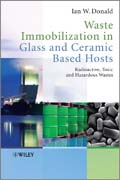
Waste immobilization in glass and ceramic based hosts: radioactive, toxic and hazardous wastes
Donald, Ian W.
This book covers aspects of both radioactive and non-radioactive wastes, topics rarely covered together. It addresses a wide range of issues, commencing with introductory chapters which present critical background information. These outline environmental aspects and provide information relating to generic sources and categories of wastes, potential disposal options, and where lessons can be learnt from nature and from a number of incidents and accidents that haveoccurred over the years. In the following chapters, immobilization of High Level Waste and special categories of Intermediate Level Waste are covered in depth. These provide details of specific waste systems, in addition to more conventional wastes from spent fuel reprocessing and defence operations. Vitrification techniques, the types of glasses employed or proposed as wasteforms, glass-ceramic based hosts, glass-encapsulated ceramic wasteforms, and relevant ceramic phases are discussed. The characterization of radioactive wasteforms, a critical issue with significant implications for assessing their very long-termstability, is also addressed. Future prospects for radioactive waste immobilization are also outlined with particular reference given to the treatment of new generation wastestreams that will be produced, for example, from the recycling of spent fuel from Generation IV (Gen4) nuclear energy systems. Non-radioactive hazardous and toxic wastes and wasteforms are subsequently reviewed in considerable depth. These wastes are numerous and diverse in nature, ranging from municipal incinerator ashes to waste asbestos products, currently creating serious environmental challenges. The influence of microbial activity on wasteform stability, both radioactive and non-radioactive is reviewed. The book continues with chapters offering comparisons between non-radioactive and hazardous waste immobilization and suggests where lessons learnt by the nuclear industries over many years may be usefully applied to the immobilization of non-radioactive hazardous waste systems. In conclusion, an outlook for the future is provided. Throughout the book, comprehensive reviews of the current state-of-the art and research progress are provided within each topic, with particular emphasis placed on progress within the last ten years. An extensive range of references is provided, making this book an up-to-date reference source.Ian Donald, Atomic Weapons Establishment (AWE), UK. Ian Donald has specialised in various areas of glass technology for over 30 years. After receiving a PhD from the University of Leeds in 1973 he continued with postdoctoral studies at the University of Warwick.. This was followed by research on metallic glasses at the University of Sheffield. Subsequently, Dr. Donald joined the Atomic Weapons Research Establishment (later to become the Atomic Weapons Establishment, ARE) in 1981. He was promoted to the grade of Distinguished Scientist in 2002, and was awarded the John Challens Medal for Lifetime Achievement by AWE in 2006. His work at AWE has included a diverse range of topics and has coveredspeculative research on a variety of glass, ceramic and glass-ceramic materials, as well as component development programmes including the research and development of chemically strengthened glasses with frangible (command-break) properties, glass-coated microwire, glass- and glass-ceramic-to-metal seal devices and coatings, glass and glass-ceramic matrix composites and, over the last 14 years, glasses and ceramics as hosts for immobilizing radioactive wastes. Over this period, Dr Donald has presented many papers at international conferences on waste-related topics. Dr Donald is an elected member of national and international technical committees on glass including the Basic Science and Technology Committee of the Society of Glass Technology together with the Committeeon Nucleation, Crystallization and Glass-Ceramics of the International Commission on Glass, representing the UK. He is also a Fellow of both the Institute of Materials, Minerals and Mining and the Society of Glass Technology, is an Associate Member of the Institute of Physics, has served time as a Visiting Professor at the University of Reading, is author or co-author of over 100 technical publications in the open literature, including a book written at the invitation of the Society of Glass Technology on Glass-to-Metal Seals, and is a member of the EPSRC Peer Review College.
- ISBN: 978-1-4443-1937-8
- Editorial: Wiley-Blackwell
- Encuadernacion: Cartoné
- Páginas: 528
- Fecha Publicación: 09/04/2010
- Nº Volúmenes: 1
- Idioma: Inglés
